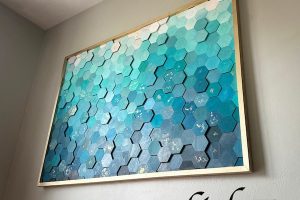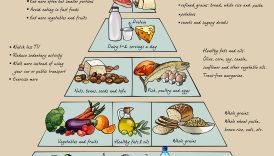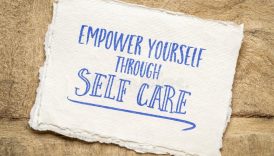Adding Depth and Character with Dimensional Wall Art

Importance of Wall Art in Interior Design
When it comes to designing a space, many people focus predominantly on furniture, color schemes, and lighting. However, wall art is often the unsung hero in interior design. It plays a crucial role in transforming a dull, plain wall into a vibrant focal point that enhances the overall aesthetic of a room. Imagine walking into a living room with bare walls versus one adorned with captivating dimensional wall art; the difference is palpable.
- Adding Depth and Character with Dimensional Wall Art
- Importance of Wall Art in Interior Design
- Setting the Mood
- Enhancing Space Perception
- Types of Dimensional Wall Art
- Sculptural Wall Art
- Textured Wall Art
- Choosing the Right Dimensional Wall Art
- Matching Wall Art with Interior Decor
- Size and Placement Considerations
- DIY Dimensional Wall Art Ideas
- Paper Wall Sculptures
- Geometric Wood Art Pieces
- Incorporating Dimensional Wall Art in Different Spaces
- Living Room Decor
- Office Workspace Enhancement
Setting the Mood
Wall art significantly contributes to the mood and atmosphere of a space. Here are a few ways it does so:
- Personal Expression: Art reflects personal taste and style, allowing homeowners to showcase their personality. For example, a collection of abstract sculptures can give a modern edge, while vintage paintings might evoke feelings of nostalgia.
- Visual Interest: Dimensional wall art adds depth and texture, breaking the monotony of flat surfaces. This three-dimensional aspect can draw the eye and encourage exploration of the space.
- Thematic Consistency: Art can unite disparate elements of a room. A well-chosen piece can tie together various colors and styles, creating a harmonious look that feels cohesive.
Enhancing Space Perception
Interestingly, wall art can alter the perception of space in a room:
- Creating Illusions: Strategic placement of dimensional pieces can create an illusion of height or width, making a small room appear larger or a long hallway feel more inviting.
- Focal Points: Artwork can serve as a visual anchor in a room, guiding the viewer’s eye and directing attention where desired.
For example, in a narrow hallway, placing a series of textured wall panels could make the space more inviting and visually stimulating. In summary, wall art is not merely decorative; it is an integral part of effective interior design. Its ability to express personality, enhance space perception, and foster emotional connections is what makes it essential for any thoughtfully curated environment. Whether you’re looking to create a cozy ambiance or a vibrant statement, the right wall art can make all the difference in your home.
Types of Dimensional Wall Art
Sculptural Wall Art
One of the most captivating forms of dimensional wall art is sculptural wall art. This type of art adds a profound, three-dimensional presence to any space, enticing viewers to engage with the artwork on a more personal level. Sculptures can vary widely in size, shape, and material, allowing for immense flexibility in design.
- Materials:Sculptural pieces can be made from various materials, including metals, wood, glass, and even fabric. Each material brings its unique characteristics:
- Metal: Offers a modern or industrial edge, often reflecting light beautifully.
- Wood: Provides a warm, organic feel; think rustic or artisanal.
- Glass: Creates an elegant and ethereal effect, particularly when light filters through.
- Forms and Styles: Sculptural wall art ranges from abstract shapes to representational figures or nature-inspired designs. For instance, a large metal tree installation can bring a sense of nature indoors, while abstract geometric sculptures can add a contemporary flair.
A personal favorite is a wall-mounted metal fish sculpture that adds a playful touch to a beach-themed room, beautifully catching the light.
Textured Wall Art
In contrast to the perhaps more rigid lines of sculptural art, textured wall art focuses on the application of various textures to create visual and tactile interest. This type of art can involve layering materials or utilizing paint techniques that add depth and intrigue.
- Material Choices:Textured wall art can be crafted using:
- Canvas: Layered paint techniques create depth and dimension, perfect for those who appreciate painting.
- Mixed Media: Combining fabric, paper, and found objects can result in engaging, unique pieces.
- Plaster or Resin: These materials can be sculpted to create highly textured surfaces that are both striking and engaging.
- Design Techniques:Textured art can invite viewers to interact with it, as they may be tempted to touch its surface. Some popular techniques include:
- Impasto: Thick paint applied to a canvas, creating peaks and valleys that cast shadows.
- Collage: Using different materials layered together to form a cohesive piece.
In a dining area, a vibrant textured piece can act as a stunning backdrop, drawing guests’ attention and sparking conversation. The beauty of dimensional wall art lies in its ability to captivate and engage, making spaces feel alive and welcoming. Exploring sculptural and textured wall art is a delightful journey for anyone looking to elevate their interior decor.
Choosing the Right Dimensional Wall Art
Matching Wall Art with Interior Decor
Selecting the perfect dimensional wall art goes beyond merely picking something that looks nice; it involves harmonizing the artwork with your existing interior decor. The art you choose can either blend seamlessly into your decor or stand out as a striking focal point. Here are some tips to ensure a perfect match:
- Consider the Style: Take stock of your room’s overall style—be it modern, eclectic, rustic, or minimalist. For example, a sleek, metallic sculpture fits wonderfully in a modern setting, while a handmade wooden piece may enhance rustic decor.
- Color Coordination: Look at the color palette of your furnishings. Your wall art should either complement the existing colors or introduce a harmonious contrast. For instance, a bright, abstract paper sculpture can add vibrancy against a neutral wall, making it pop while still maintaining a cohesive look.
- Personal Sentiment: Choose pieces that resonate with you personally. Perhaps you collected certain items during your travels or wish to display art from a local artist. These choices can enhance the emotional connection to your space.
Personalizing your decor not only reflects your tastes but also encourages conversations when guests visit, showcasing what truly matters to you.
Size and Placement Considerations
Once you’ve pinpointed the right type of dimensional wall art, it’s essential to consider size and placement to maximize its impact. Getting this right can completely change the atmosphere of the space.
- Scale Matters:The size of the artwork should relate proportionally to the wall it will occupy. Here’s a quick guide:
- Small Artworks: Best for clustered arrangements or creating a gallery wall.
- Medium Artworks: Works well above furniture like a sofa or console.
- Large Artworks: Ideal for grand statements in entryways or over mantels.
- The Rule of Thirds: For placing wall art, consider the rule of thirds—hang pieces at eye level, approximately 57 to 60 inches from the floor. This height allows your artworks to be seen and appreciated without straining.
- Create Balance: Ensure that the art is balanced with other elements in the room. For instance, if you have a large piece on one side of a room, consider symmetry with another piece or a larger piece on the opposing wall to achieve equilibrium.
In a personal example, in my living room, I opted for a large sculptural piece above the sofa; it draws the eye immediately and balances the overall look of the room. Choosing the right dimensional wall art is more than just aesthetics—it’s about creating a space that feels right and reflects personal taste and flair.
DIY Dimensional Wall Art Ideas
Paper Wall Sculptures
If you’re looking for an engaging and cost-effective way to add depth to your walls, consider creating paper wall sculptures. This art form provides endless possibilities to express creativity, and the materials are often readily available at home or easily found at a craft store.
- Materials Needed:
- Colored cardstock or scrapbook paper
- Scissors or a craft knife
- Glue or a glue gun
- A frame or backing board (optional)
- Hot glue gun for added sturdiness
- Basic Steps:
- Choose a Design: Start with a simple design. Flowers, geometric shapes, or abstract patterns work well.
- Cut the Paper: Layer multiple pieces of paper, cutting them into your desired shapes while varying the sizes to create a 3D effect.
- Layering: Use the glue to attach the cutouts to a backing board, ensuring that the pieces are spaced apart to enhance the 3D look.
- Mounting: For added interest, consider framing your sculpture or mounting it directly onto the wall.
A personal favorite of mine was creating a stunning paper flower sculpture for my dining area. It not only made the wall pop but also became a playful conversation starter during dinner parties.
Geometric Wood Art Pieces
Another fantastic DIY option for dimensional wall art is geometric wood art pieces. This project adds warmth and an organic touch to your interiors while giving you a sense of accomplishment.
- Materials Needed:
- Assorted wood pieces (pallet wood works well)
- Wood glue or nails
- Saw (if cutting your own shapes)
- Sandpaper
- Paint or wood stain (optional)
- Basic Steps:
- Design Your Pattern: Sketch out your geometric design on paper. Think triangles, hexagons, or a mix of shapes.
- Cut the Wood: Based on the sketches, cut your wood pieces into the desired shapes.
- Prepare the Surface: Sand any rough edges to ensure a smooth finish.
- Assembly: Use wood glue or nails to connect the pieces together, creating depth by layering them.
- Finish It Off: Paint or stain the pieces to secure the desired look and color for your room.
I recently created a wooden geometric wall art piece for my home office, combining varying shades of wood to mimic a sunset. It brought life into the space while reflecting my personality. Both paper wall sculptures and geometric wood art pieces offer fantastic opportunities for self-expression and can dramatically enhance your home decor. With just a little time and creativity, you can create stunning focal points that reflect your style and add dimension to your living spaces.
Incorporating Dimensional Wall Art in Different Spaces
Living Room Decor
The living room is often the heart of a home, a space where family and friends gather, making it the perfect area to showcase dimensional wall art. This type of art can create an inviting atmosphere while also serving as a central focal point. Here are some tips on how to use dimensional wall art to enhance your living room decor:
- Create a Statement Wall: Choose a large sculptural piece or a collection of smaller artworks to create a gallery wall. A mix of textures and materials can add depth, such as combining wood, metal, and fabric.
- Use Proportions Wisely: If you have a spacious living room, consider a large piece above the sofa or fireplace to draw the eye upward and emphasize ceiling height. Conversely, if space is limited, smaller pieces can be arranged in clusters to create a quaint, cozy feel.
- Color Coordination: Choose art that either contrasts or complements the colors in your decor. For instance, a bright, colorful wall sculpture can lift the mood, especially when placed against a neutral backdrop.
I remember transforming my living room by adding a large, colorful paper sculpture that hung above the couch. The moment it was up, guests began to notice and talk about it, sparking conversations and adding life to our gatherings.
Office Workspace Enhancement
Incorporating dimensional wall art in a workspace can significantly enhance the overall mood and productivity levels. A creative and inspiring environment can lead to increased motivation, making the right art choices essential. Here’s how to effectively integrate dimensional wall art in your office:
- Inspire Creativity: Choose artworks that inspire your creative side. Abstract geometric forms, colorful paper sculptures, or textured wood art can keep you uplifted during the workday.
- Define Zones: If your office layout has different functional areas, consider using art to delineate these spaces. For instance, a calming textured piece in the relaxation nook can create a peaceful vibe, while bold art in the main work area can energize the space.
- Personal Touches: Incorporate pieces that reflect your personality and interests. Whether it’s art from local artists, motivational quotes in a 3D format, or sculptures that relate to your profession, these personal touches can make your workspace feel more welcoming.
In my home office, I added a series of small, geometric wood art pieces above my desk. Not only did they enhance the design, but they also sparked creativity while I worked, making my workspace more enjoyable. In conclusion, dimensional wall art can transform both living spaces and workspaces by adding character, depth, and a sense of personal touch. With thoughtful placement and the right pieces, you can create a harmonious environment that reflects your style and enhances your everyday life.





